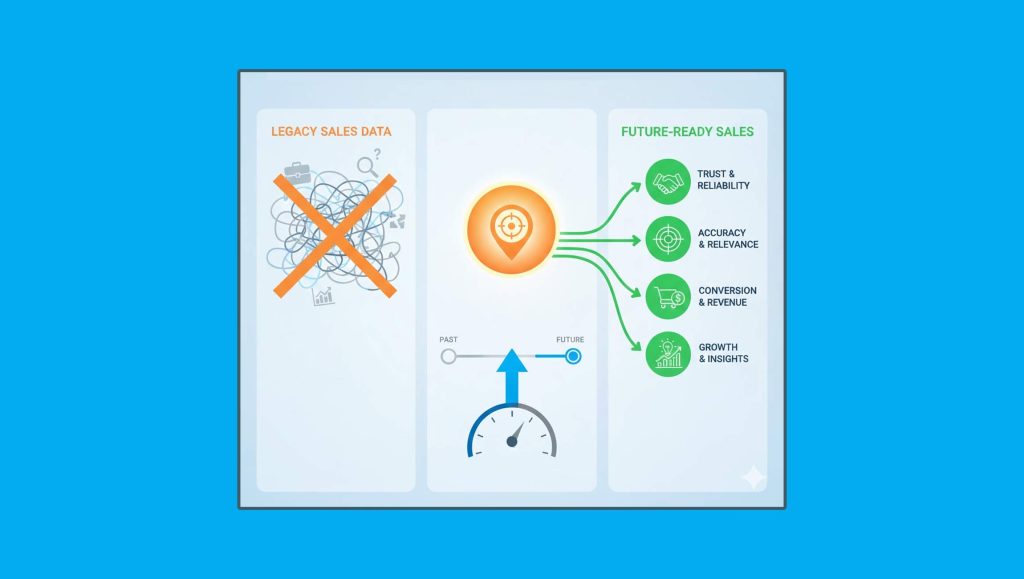Imagine, what if someone removed apples for your apple pie, would the apple pie make sense? Similarly, if you remove data from your marketing or sales campaign, the campaign wouldn’t make much sense.
Modern marketers and sales people believe that data analytics plays a pivotal role in shaping the future of their outreach and campaigns. Everyone is on board with the importance of data analytics, but yet many still fail to implement data to their advantage.
Modern B2B sales and marketing teams understand the importance of data and analytics in shaping the future of their brand growth goals.
Here is a little guidance on how you can avoid some common marketing analytics and sales data mistakes to make your data journey smoother.
1. Don’t Pool in Data to your Marketing or Sales Plan Very Late
Data is a game-changer for any marketing and sales plan. If you wait until the last minute to use data, you are missing out on opportunities to improve your results.
At times, data may prove your well-thought-out video script or an anecdote for an ad wrong. However, you should not let this stop you from using data to make decisions. Data can help you make smarter decisions that are less likely to be based on gut instinct.
Further advice: Data and creativity should work together. Use data to inform your creative decisions, but don’t let it stifle your creativity.
2. Presenting Data Through Wrong Visualization Methods
Data visualization is a powerful tool that can help you communicate your findings in a clear and concise way. However, if you choose the wrong visualization method, you can actually make your data harder to understand.
When choosing a visualization method, it is important to consider the type of data you are working with and the audience you are trying to reach. For example, if you are trying to show trends over time, a line chart would be a good choice. However, if you are trying to compare different groups, a bar chart would be a better option.
Further advice: Choose your visualization technique after diving into your data. Knowing the data will help you determine the kind of graphic that will best tell your data story.
3. Depending more on Vanity Metrics
Vanity metrics are metrics that are easy to measure but do not necessarily tell you anything about the effectiveness of your marketing campaigns. For example, the number of likes on a social media post is a vanity metric. It is easy to measure, but it does not tell you whether the post is actually driving sales or leads or pipeline and purchase interest of any kind.
It is important to focus on metrics that are more meaningful, such as website traffic, leads generated, and sales closures. These metrics will give you a better understanding of how your marketing and sales campaigns are performing and whether they are helping you achieve your business growth goals.
Further advice: Vanity metrics aren’t useless, but they should not be the only metrics you track. Use vanity metrics to get a general sense of how your marketing campaigns are performing, but focus on more meaningful metrics to track your progress.
4. Relying too Much on Data
Data is a valuable tool, but it is important to remember that it is not the only factor that matters in marketing and sales. You should also consider your gut instinct to some extent, take into account your experience, and the feedback of your customers when making decisions.
If you rely too much on data, you may miss out on opportunities to connect with your customers on a human level. Data can help you make informed decisions, but it should not be the only factor you consider.
Further advice: People will always matter, data can help you draw inferences, but at last, the people will build copy, design campaigns, ads, and videos with which your audience will associate their lives.
5. Not Building a Data-focused Future
Data is a powerful tool that can help you improve your marketing and sales campaigns and achieve your business goals. However, it is important to remember that data is only as good as the people who use it.
If you want to get the most out of data, you need to create a data-driven culture within your organization. This means that everyone in your organization, from the top leaders to the junior team members need to be committed to using data to make decisions.
Creating a data-driven culture takes time and effort, but it is worth it. When everyone in your organization is using data to make decisions, you can make better, more informed decisions that will help you achieve your business goals.
Further advice: Do not collect data if you do not know what to do with it. Using data is a must, but you need to shift away from using it as a fad and refocus on the ways you can embed data into driving goals.
Read More: E-commerce Businesses Can Fight Inflation – Here’s How
Wrapping Up:
Data is a powerful tool that can help you improve your marketing and sales campaigns and help achieve your business goals. However, it is important to avoid common marketing analytics and sales mistakes and to create a data-driven culture within your organization. By following these tips, you can use data to your advantage and achieve your marketing and sales growth goals more effectively.





















